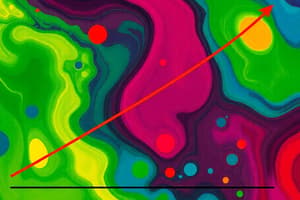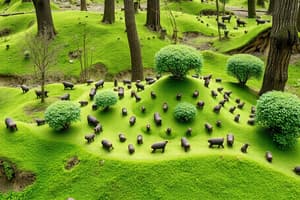Podcast
Questions and Answers
Which of the following describes the component parts of an exponential growth model and how they interact?
Which of the following describes the component parts of an exponential growth model and how they interact?
- Births and deaths (correct)
- r- and K-strategists
- Density-dependent and density-independent factors
- Immigration and emigration
Which type of factors provide feedback into a population model?
Which type of factors provide feedback into a population model?
- Density-dependent and density-independent factors (correct)
- r- and K-strategists
- Births and deaths
- Immigration and emigration
What are the factors that limit logistic growth?
What are the factors that limit logistic growth?
- Density-dependent and density-independent factors (correct)
- Immigration and emigration
- r- and K-strategists
- Births and deaths
What do r- and K-strategists refer to in population ecology?
What do r- and K-strategists refer to in population ecology?
What factor contributes to population regulation through accumulation?
What factor contributes to population regulation through accumulation?
Which of the following represents the maximum population size a given environment can sustain?
Which of the following represents the maximum population size a given environment can sustain?
What pattern of mortality rates over an organism's life is seen in survivorship curve?
What pattern of mortality rates over an organism's life is seen in survivorship curve?
What does r (intrinsic growth rate) determine in the exponential growth model?
What does r (intrinsic growth rate) determine in the exponential growth model?
In which situation is the population decreasing, with death rates higher than birth rates?
In which situation is the population decreasing, with death rates higher than birth rates?
What represents the per capita rate of increase in the population according to the exponential growth model?
What represents the per capita rate of increase in the population according to the exponential growth model?
Which example represents a trade-off between survival and paternal care?
Which example represents a trade-off between survival and paternal care?
What influences population growth and is considered a chance event or external factor?
What influences population growth and is considered a chance event or external factor?
What represents population growth following an exponential pattern, eventually reaching carrying capacity?
What represents population growth following an exponential pattern, eventually reaching carrying capacity?
When is a stable population achieved?
When is a stable population achieved?
What spacing patterns occur in birds such as black-browed albatross due to competition for nesting sites?
What spacing patterns occur in birds such as black-browed albatross due to competition for nesting sites?
What represent single breeding vs. multiple breeding and their impact on the environment?
What represent single breeding vs. multiple breeding and their impact on the environment?
What does the logistic population growth model incorporate that the exponential population growth model does not?
What does the logistic population growth model incorporate that the exponential population growth model does not?
In what type of conditions does exponential population growth occur?
In what type of conditions does exponential population growth occur?
What is the impact of population size on the rate of increase in exponential growth?
What is the impact of population size on the rate of increase in exponential growth?
What are examples of density-dependent limitations on population size?
What are examples of density-dependent limitations on population size?
What types of limitations affect population size regardless of population density?
What types of limitations affect population size regardless of population density?
When does logistic growth begin to slow down?
When does logistic growth begin to slow down?
What type of competition can result in resources becoming less available per capita as population density increases?
What type of competition can result in resources becoming less available per capita as population density increases?
Which factors become more prevalent and effective as population density increases?
Which factors become more prevalent and effective as population density increases?
What does the J-shaped curve depict in relation to exponential growth?
What does the J-shaped curve depict in relation to exponential growth?
What is the mathematical expression for the population growth rate?
What is the mathematical expression for the population growth rate?
What does the logistic growth model incorporate to limit growth?
What does the logistic growth model incorporate to limit growth?
What type of growth is depicted by a sigmoidal curve?
What type of growth is depicted by a sigmoidal curve?
Flashcards are hidden until you start studying
Study Notes
- Population growth rate is calculated as the difference between the number of births and deaths per individual during a specified time interval (birth rate - death rate)
- Population growth rate can be expressed mathematically as the change in population size (N) over time (ΔN Δt) and the per capita rate of increase (r)
- Exponential population growth refers to idealized conditions where population increase is at its maximum rate (rmax)
- Exponential growth is depicted by a J-shaped curve, with the rate of increase being constant but the population accumulating more new individuals per unit time when it is large than when it is small
- Logistic population growth is a more realistic population model that limits growth by incorporating carrying capacity (K), which is the maximum population size the environment can support
- Logistic growth is described by a sigmoidal curve, which begins slowing as the population nears its carrying capacity
- Factors that affect population size in relation to population density (density-dependent limitations) include competition, disease, predation, and territoriality
- Factors that limit population size regardless of population density (density-independent limitations) include climate, disease, volcanic eruptions, and human activities
- Competition can occur between species (interspecific competition) or within species (intraspecific competition), and can result in resources becoming less available per capita as population density increases
- Disease and predation can also affect population size, with disease becoming more prevalent and predation becoming more effective as population density increases.
Studying That Suits You
Use AI to generate personalized quizzes and flashcards to suit your learning preferences.




